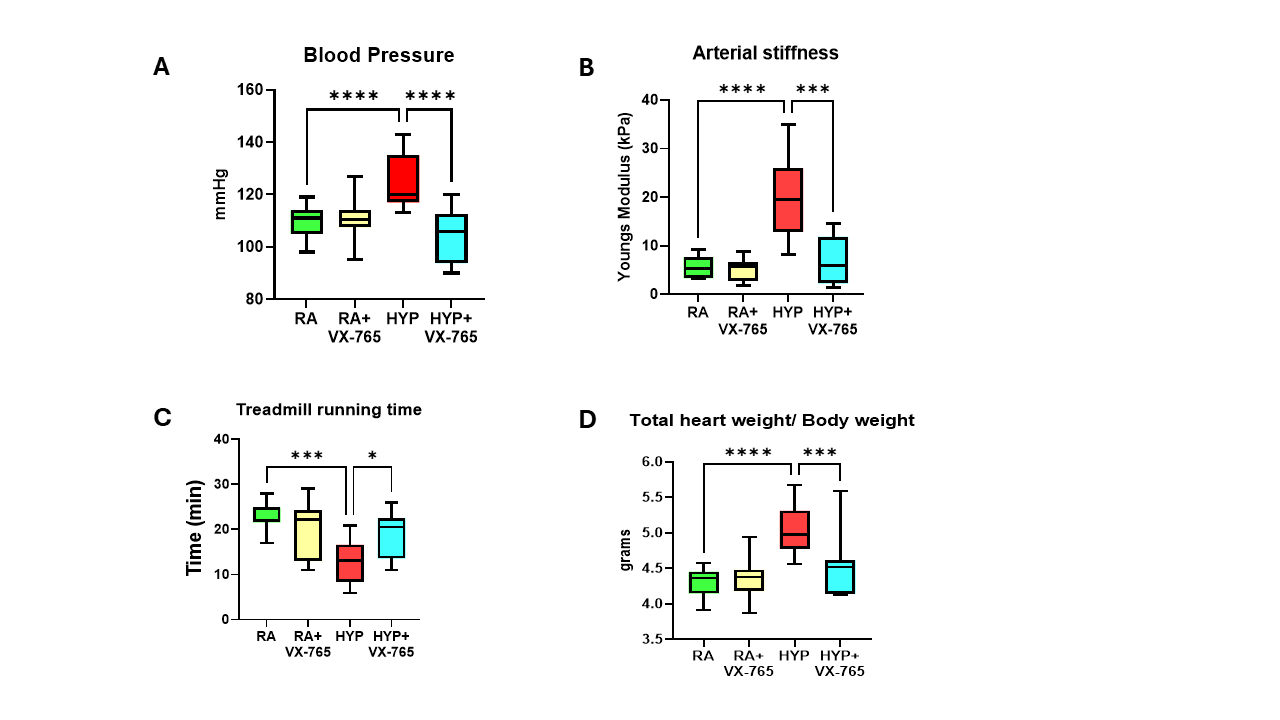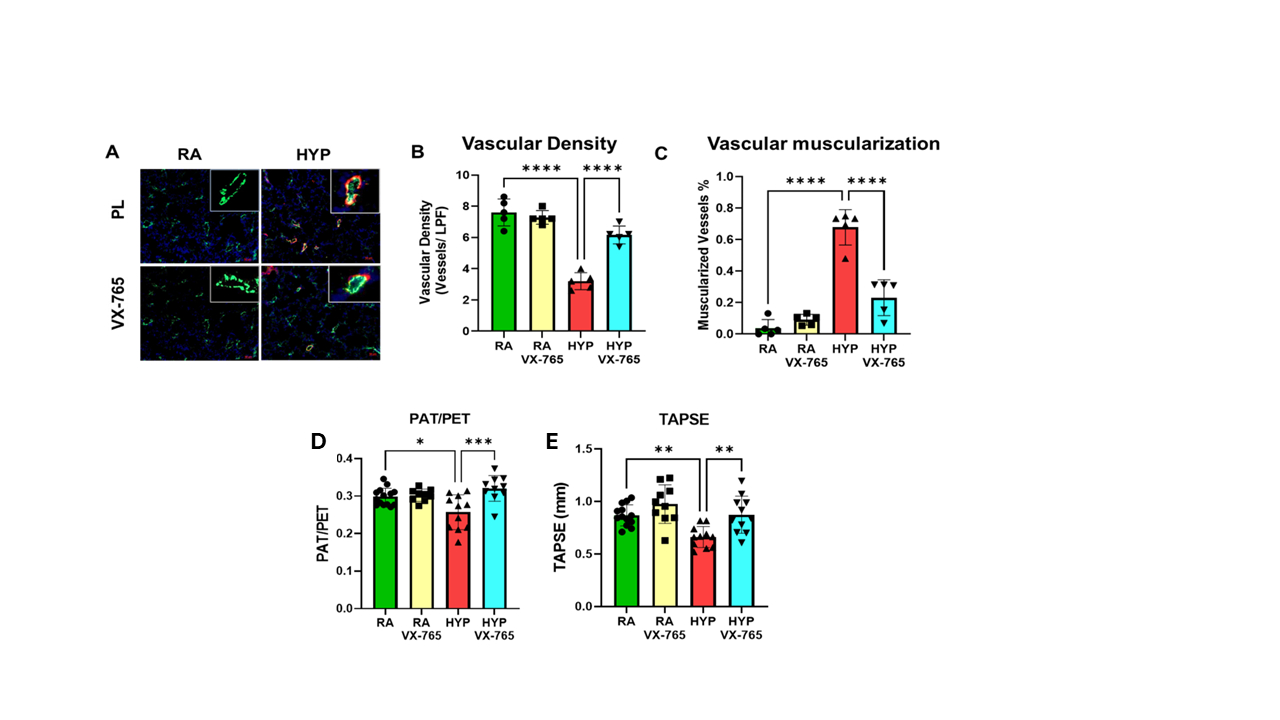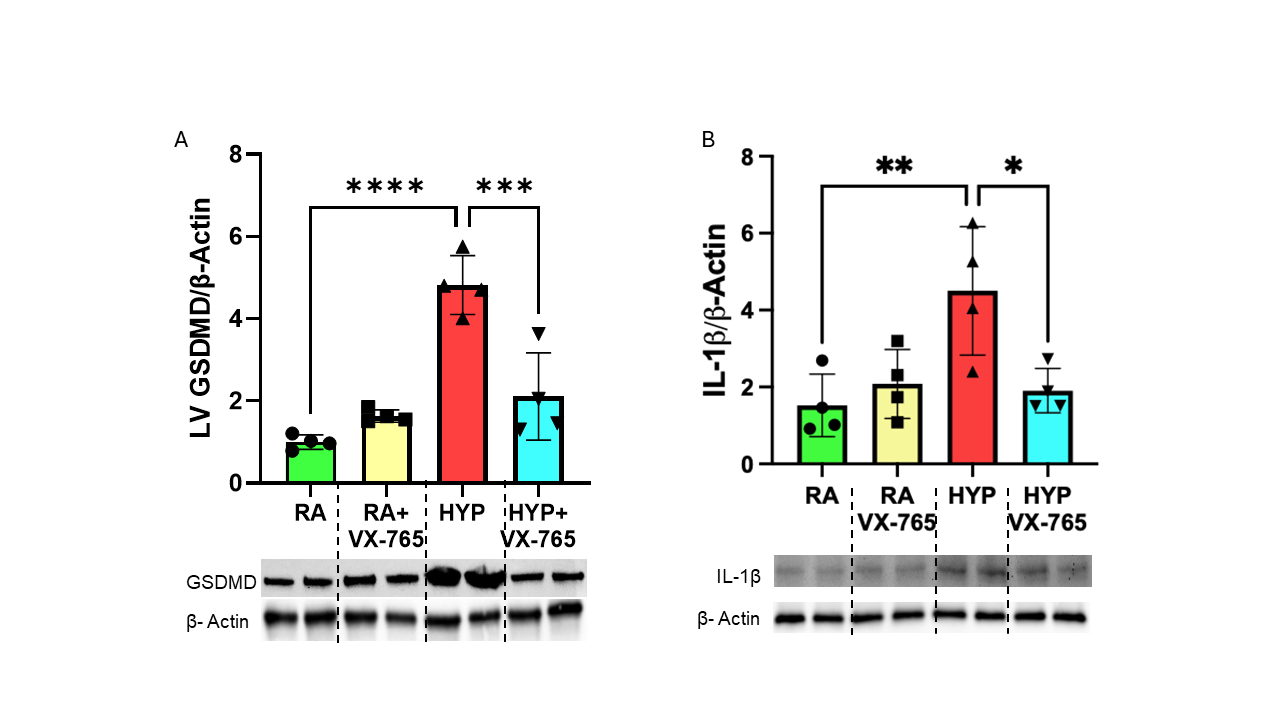Final ID: 61
Protective role of caspase-1 inhibition in experimental model of neonatal hyperoxia-induced cardiopulmonary dysfunction in adults born preterm.
Abstract Body: Background: Adults born preterm are at an increased risk of systemic hypertension and cardiopulmonary morbidities. However, little is known of the underlying mechanisms connecting neonatal hyperoxia (O2) exposure to these long-term cardiovascular consequences in adults born preterm. Pro-inflammatory caspase-1 mediates the activation of cytokines IL-1β, and pore-forming protein Gasdermin-D.
Objective: Test the hypothesis that caspase-1 inhibition prevents long-term cardiopulmonary consequences of preterm birth.
Design/Methods: Newborn mice (n=60) exposed to normoxia (RA) or hyperoxia (O2) from postnatal day (P) 1 to 14 were randomly assigned to receive daily intraperitoneal (IP) injections of caspase-1 inhibitor (VX-765, 50 ug/Kg) or DMSO as placebo. The mouse pups recovered in RA into adulthood until 3 months of age. The effect of caspase-1 inhibition on Blood pressure (BP), exercise endurance, cardiac function, systemic vascular stiffness, pulmonary vascular remodeling was assessed at 3 months.
Results: Adult rats exposed to neonatal O2 had significantly increased BP associated with vascular stiffness, reduced exercise capacity, cardiac hypertrophy, and cardiovascular inflammation. Caspase-1 inhibition prevented systemic hypertension, systemic vascular stiffness, improved exercise tolerance and decreased cardiac hypertrophy (Fig 1A-D) in adult mice exposed to neonatal O2. Moreover, caspase -1 inhibition improved pulmonary vascular remodeling and pulmonary hypertension in these mice (Fig 2A-E). Additionally, western blot analysis demonstrated that early supplementation of VX-765 in O2 exposed mice led to reduced cardiac proinflammatory markers GSDMD and IL-1β in adulthood (Fig 3A-B).
Conclusion: Neonatal O2 exposure predisposes to cardiopulmonary morbidities in adults born preterm. Inhibition of caspase-1 reduces cardiovascular inflammation and cardiopulmonary dysfunction in mice exposed to hyperoxia during the neonatal period. The functional and molecular impact of the use of caspase-1 suggests that it can be used as a novel preventive strategy for long-term cardiopulmonary dysfunction due to neonatal O2 exposure in preterm survivors.
Objective: Test the hypothesis that caspase-1 inhibition prevents long-term cardiopulmonary consequences of preterm birth.
Design/Methods: Newborn mice (n=60) exposed to normoxia (RA) or hyperoxia (O2) from postnatal day (P) 1 to 14 were randomly assigned to receive daily intraperitoneal (IP) injections of caspase-1 inhibitor (VX-765, 50 ug/Kg) or DMSO as placebo. The mouse pups recovered in RA into adulthood until 3 months of age. The effect of caspase-1 inhibition on Blood pressure (BP), exercise endurance, cardiac function, systemic vascular stiffness, pulmonary vascular remodeling was assessed at 3 months.
Results: Adult rats exposed to neonatal O2 had significantly increased BP associated with vascular stiffness, reduced exercise capacity, cardiac hypertrophy, and cardiovascular inflammation. Caspase-1 inhibition prevented systemic hypertension, systemic vascular stiffness, improved exercise tolerance and decreased cardiac hypertrophy (Fig 1A-D) in adult mice exposed to neonatal O2. Moreover, caspase -1 inhibition improved pulmonary vascular remodeling and pulmonary hypertension in these mice (Fig 2A-E). Additionally, western blot analysis demonstrated that early supplementation of VX-765 in O2 exposed mice led to reduced cardiac proinflammatory markers GSDMD and IL-1β in adulthood (Fig 3A-B).
Conclusion: Neonatal O2 exposure predisposes to cardiopulmonary morbidities in adults born preterm. Inhibition of caspase-1 reduces cardiovascular inflammation and cardiopulmonary dysfunction in mice exposed to hyperoxia during the neonatal period. The functional and molecular impact of the use of caspase-1 suggests that it can be used as a novel preventive strategy for long-term cardiopulmonary dysfunction due to neonatal O2 exposure in preterm survivors.
More abstracts on this topic:
Acculturation and Cardiovascular-Kidney-Metabolic Syndrome: a Study of Immigrant Adults From the National Health and Nutrition Examination Survey
Chakrabarti Amit, Le Austin, Elfassy Tali, Yang Eugene
A Randomized Phase 2 Trial of Muvalaplin: An Oral Disrupter of the Assembly of Lipoprotein(a) ParticlesNicholls Stephen, Ni Wei, Rhodes Grace, Nissen Steven, Navar Ann Marie, Michael Laura, Krege John



